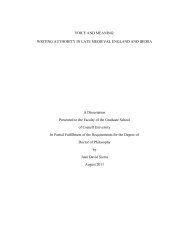Briana Anderson - Cornell University
Briana Anderson - Cornell University
Briana Anderson - Cornell University
You also want an ePaper? Increase the reach of your titles
YUMPU automatically turns print PDFs into web optimized ePapers that Google loves.
7<br />
A popular advertising vehicle is the use of endorsers 3 for products. Research<br />
has examined the credibility of endorsers based on certain attributes, i.e. expertise,<br />
trustworthiness, and attractiveness (Ohanian, 1990), and the effect of audience attitude<br />
toward the advertisement/message. Furthermore, research has been conducted on the<br />
impact of endorsers on perceived credibility of the organization as well as endorser<br />
credibility effect on attitude toward the advertisement. Results of this research<br />
indicate that perceived endorser credibility is correlated with positive attitude toward<br />
the advertisement (Goldsmith et al., 2000; Lafferty & Goldsmith, 1999).<br />
This study focuses on the ‘attractiveness’ attribute related to endorser<br />
credibility. Physical attractiveness is the independent variable of interest in this study<br />
for one very important reason: it is the most readily available and visible (and<br />
sometimes the only available) variable that is presented by an endorser. 4 The Source<br />
Attractiveness Model posits that the effectiveness of a message is related to the<br />
similarity, familiarity, and liking of an endorser (McGuire, 1968), as well as audience<br />
desire to identify with attractive endorsers (Kelman, 1961). The basic premise of this<br />
model is that attractive endorsers are perceived as more credible and are therefore<br />
more effective at selling the product or idea in the advertisement (Erdogan et al.,<br />
2001). McGuire (1985) argues that attractiveness is important to persuasive impact to<br />
the extent that the receiver is motivated to enhance sense of self, social reputation, or<br />
gratifying role relationships by identifying with admired sources and introjecting their<br />
attitudes (also known as ‘identification’: Kelman, 1961). The concept of<br />
“likeability”, a common sense assumption that a likeable source is more attractive, is<br />
supported by research (see: Sampson & Insko, 1964). Research on source<br />
3 Note: At this stage, I am not distinguishing between type of endorser/spokesperson/model. As you<br />
will read later, the focus will be on one attribute (i.e. attractiveness) and how it relates to perceived<br />
credibility of a message.<br />
4 This assumption assumes that levels of expertise and all other potential confounding variables related<br />
to an endorser’s perceived credibility are held constant.

















